Cleaning paint drop cloths is crucial in maintaining their durability and ensuring their longevity for future projects. Start by allowing any wet paint on the drop cloth to dry completely. Once dry, use a stiff brush or scraper to remove as much dried paint as possible. For water-based paints, use a mix of mild detergent and water. Apply the soapy solution to stained areas and gently scrub with a brush or sponge. Consider using paint thinner or mineral spirits for oil-based paints, but be cautious and follow safety guidelines. After scrubbing, rinse the drop cloth thoroughly with clean water and allow it to air dry.
For persistent stains, especially on canvas drop cloths, consider making a paste by combining baking soda and water. Apply the paste to the stained region, allow it to sit, and then use a brush to scrub. This method is often effective in lifting tough paint stains. Remember to check the care instructions provided by the manufacturer, as some drop cloths may have specific cleaning recommendations. By incorporating proper cleaning practices into your routine, you not only extend the life of your paint drop cloth but also ensure a clean and reliable canvas for your next painting endeavor.
Mastering the Art of Cleaning Paint Drop Cloths
Cleaning paint drop cloth is an essential skill for any DIY enthusiast or professional painter looking to maximize the lifespan of their protective gear. Begin by addressing fresh paint stains immediately. Blot excess wet paint with absorbent materials like paper towels or rags to prevent it from seeping deeper into the fabric. Carefully scrape off the surface layer with a putty knife or scraper for dried paint. Once you've tackled the initial cleanup, assess the type of paint you're dealing with. Water-based paints often respond well to mild detergent and warm water. Use the soapy mixture on the affected area and softly scrub with a brush or sponge.
A baking soda paste can work wonders for heavier stains or more robust fabrics like canvas drop cloths. Blend baking soda with water to produce a paste, administer it onto the stained region, and allow it to sit before using a brush for scrubbing. This technique is particularly effective against stubborn paint residues. Always refer to the manufacturer's instructions to ensure you employ the suitable cleaning method for your specific drop cloth. By mastering the art of cleaning paint drop cloths, you maintain a tidy workspace and extend the usability of your protective gear for future projects.
Stain-Free Success: Tips for Cleaning Paint Splatters from Drop Cloths
When dealing with fresh paint splatters, swift action is key. Blot excess wet paint with absorbent materials like paper towels or old rags to prevent it from spreading or penetrating deeper into the fabric. To address dried paint splatters, delicately remove as much as possible using a putty knife or scraper. Once you've addressed the immediate issue, assess the type of paint involved. Consider using paint thinner or mineral spirits for oil-based paints, ensuring you follow safety guidelines. After cleaning, thoroughly rinse the drop cloth with water and allow it to air dry for optimal results.
Consider a baking soda paste for stubborn paint splatters, especially on canvas drop cloths. Apply a mixture of baking soda and water paste to the affected area. Let the paste sit for some time to penetrate the paint, then use a brush to scrub the residue away. This method is effective for lifting tough paint stains without causing damage to the fabric. Always refer to the manufacturer's instructions to ensure you employ the appropriate cleaning techniques for your specific drop cloth material. By following these tips, you can accomplish stain-free success and maintain the pristine condition of your drop cloths for future painting projects.
Preserving Quality: A Step-by-Step Tutorial on Washing Paint Drop Cloths
Utilize a putty knife or scraper to carefully eliminate as much dried paint as possible. Once the initial cleanup is done, assess the type of paint involved. Water-based paints often respond well to mild detergent and warm water. Administer the soapy mixture onto the affected region and softly scrub using a brush or sponge. In the case of oil-based paints, consider using paint thinner or mineral spirits, ensuring proper ventilation and safety precautions. After scrubbing, rinse the drop cloth thoroughly with clean water and allow it to air dry.
Consider a baking soda paste for a more thorough cleaning for heavier stains or fabrics like canvas drop cloths. Combine baking soda with water to form a paste, then apply it to the stained areas. After some time, use a brush to scrub away the residue. Always consult the manufacturer's care instructions to confirm that you are employing the proper cleaning methods for your particular drop cloth. Following these step-by-step guidelines, you can effectively wash your paint drop cloths and preserve their quality for continued use in your projects.
Reviving Reusables: Best Practices for Cleaning and Reusing Paint Drop Cloths
Reviving reusable paint drop cloths is not only a sustainable practice but also a cost-effective one. Start by promptly addressing any fresh paint stains to prevent them from setting into the fabric. Blot excess wet paint with absorbent materials like paper towels or rags, and for dried paint, use a putty knife or scraper to gently lift off as much as possible. Once the preliminary cleaning is done, assess the type of paint involved. Water-based paints often respond well to mild detergent and warm water. Apply the soapy solution to the stained areas and use a brush or sponge to scrub gently. Consider using paint thinner or mineral spirits for oil-based paints, ensuring proper ventilation and safety measures. After cleaning, thoroughly rinse the drop cloth with clean water and allow it to air dry to maintain its integrity for future use.
To enhance the lifespan of your reusable drop cloths, regularly clean and store them properly. If possible, designate specific drop cloths for projects to prevent cross-contamination. Folding and storing drop cloths in a cool, dry place helps prevent mold or mildew growth. By incorporating these best practices into your routine, you ensure the longevity of your reusable drop cloths and contribute to a more sustainable and eco-friendly approach to your painting endeavors.













